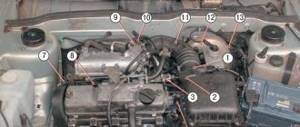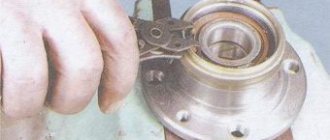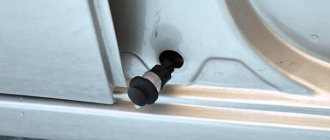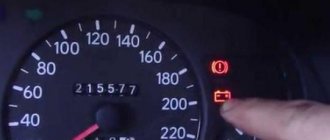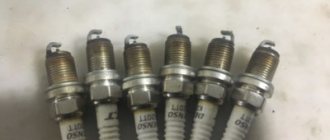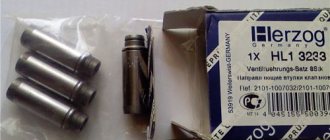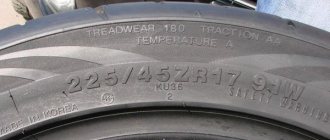Withdrawal procedure
- First of all, remove the belt from the generator.
2. Disconnect the block from terminal “D” of the generator.
3. Remove the protective cover, unscrew the nut and disconnect the wires from terminal “B+”.
4. Unscrew the tension bolt.
5. Unscrew the top mount of the generator.
6.Remove the tension bar.
7. Unscrew the lower mount of the generator.
8. Remove the spacer bushing.
9. Remove the generator mounting bolt and remove it.
Replacing the generator with power steering, eliminating noise
There was a very strange knocking sound from the engine, when you accelerate and let off the gas there is a knocking sound from the area of the generator and the steering wheel... I struggled with this for a long time, but not very successfully, in order: - the fault was on the belt roller, well, it was a little sensitive and not everything was going well with it okay, I was looking for a roller without play for a long time, but I found it and installed it, it didn’t help with the main knock; -removing the engine and power steering belt and starting the car, the knocking noise disappeared completely, well, for a long time I sinned on the power steering pump, then I replaced it, and it seemed to be better, but after some time this knocking noise came again (((... - I thought, what if it’s a generator It’s noisy, and the voltage was low when you turn everything on to 12V. I went to remove it and look, and then it started... Removing the gene on a car with power steering is another quest... I decided to remove it through the headlight, since it’s not possible to pull the receiver out through the top, but through the bottom, the pump Power steering, removing the pump means draining the oil, and then also pumping it... so it’s easier through the headlight, especially since I also changed the headlights)))
It fits through the headlight just fine, removing the headlight is not difficult))
And so, having removed the generator, I twirled it in my hands and realized that its bearings were running out...
burnt contact, apparently he was punished well at one time)
The contact from the winding is a little burnt, a stub from it remains, the bearings are damaged, the voltage sags, so I bought a new one then)))
dynamo
Dynamo 105A when the old one had 80 Next is the most interesting thing, the secret of the ominous noise is revealed...
bottom of generator mount
and this is the top part of the generator mount
that’s the reason for the noise, a mount broken in two was knocking on another engine mount.
I’ll say right away that finding a new bracket for an engine with power steering was not easy; I never found one in Bryansk! It is attached to the same bolts as the engine mount, but in order to screw it on I had to remove the pump; I removed it directly without twisting the tubes from it, but simply lowering it to the bottom)
The bottom bolt can only be tightened by removing the power steering pump
new generator next to the old one
The new one looks impressive, it has one more winding contact, the regulator is more massive, the voltage on board is 14.2 V and does not consistently respond to the heater and low beams)))) if you turn on everything you can, these are high beams, heated mirrors, emergency lights , heater, reverse, brake light...
The result is I'm happy, there is no noise, the voltage is normal, everything is fine))
- Generator 3800
- Bracket 560
Generator VAZ 2110 and VAZ 2112
The functional purpose of a car generator is to convert engine energy into electricity. The generator starts working after starting the engine from the battery and supports the operation of the ignition system and additional energy consumers.
It is the number of sources loading the generator that affects the operating life of the unit.
How to choose a generator for a VAZ 2110 or VAZ 2112
Due to the similarity of many components in the structural assemblies of the VAZ 2110 and VAZ 2112 cars, most of the electrical equipment is identical, including generators. To choose the right generator, it is necessary not only to take into account the dimensions of the device, but also to determine its rated power - for the 2110-12 generation Lada, it should be indicative of at least 55 Amperes.
| Brand/manufacturer | Trade article | Rated power | Approximate cost, rub. |
| ZiT | 372.3701-02 | 55 | 4700 |
| ZiT | 372.3701-05 | 65 | 4900 |
| BATE | 9402.3701 | 90 | 6200 |
| BATE | 9402.3702 | 95 | 6500 |
| ATE | 3202.3771000 | 75 | 5700 |
| ATE | 3202.3771034 | 70 | 5500 |
The higher the generator power, the greater the number of energy consumers the unit can support without the risk of overheating and reduced service life. Installing an increased power generator instead of the standard equipment will allow you to connect additional equipment and accessories - heated seats, high-quality car audio, a car refrigerator, etc. However, when increasing the power of the generator, it is also necessary to take care of laying power wiring with a larger cross-section of the conductive part, as well as installing a more capacious battery.
Note! If you purchase a non-standard generator, it is important to check the compatibility of the device with your car. To do this, you need to go to the official website of the manufacturer and enter the product article number and VIN number of the vehicle into the search form. If information about the part is available in the dealer database, the unit can be considered for purchase.
Dismantling the generator on a VAZ 2110 or VAZ 2112
The algorithm for dismantling the generator on a VAZ 2110 or VAZ 2112 is not complicated and can be performed with one pair of hands within 40-50 minutes. To perform the procedure, you will need an inspection pit or a car lift, as well as a set of wrenches or socket heads, a set of screwdrivers and pliers. Removing the unit from its original location is carried out in the following sequence:
- First of all, we drive the car onto a pit or a lift, after which we unscrew all the battery terminals and take out the battery itself. To remove the battery, in some cases it is necessary to unscrew the bolt on the fixing clamp;
- Next, we move to the bottom of the vehicle and remove the crankcase protection to provide free access to the engine compartment;
- After removing the protection, carefully pull back and remove the drive belt, after pressing down the tensioner with a screwdriver or wrench;
- Then unscrew and remove the power wiring leading to the generator. Now you can use sockets with extensions to remove the fixing bolts holding the generator to the bracket;
- At the end of the procedure, you can remove the unit from the car. During dismantling, it is important to monitor the position of the buffer bushing - this unit may become deformed when removed.
Note! Before repairing the generator, it is important to inspect the condition of the wiring and drive belt. If there are breaks or any other damage, the components will have to be replaced - otherwise there is a high risk of a short circuit or an accident on the road.
Disassembling the generator housing to replace components
Disassembling the generator is also not difficult. As a rule, this unit is only disassembled into parts, after which the faulty part is modularly replaced - there is no need to solder or rewind the winding. To repair a generator on a Lada, you will need the set of tools described above, as well as a pair of round nose pliers that will allow you to remove the insulation without the risk of damage. The entire scope of work takes no more than 1 hour and occurs according to the following action scenario:
- After dismantling the device from the car, you need to move the unit to a workbench or table and place the back cover up. The generator cover is fixed with 4 long bolts, which must be unscrewed and the device separated into 2 parts - the rotor and the stator;
- The upper part of the unit consists of a rotor with a shaft and bearing. To check the operating condition, you should ring the rotor with a multimeter and, if necessary, replace the bearing itself;
- The lower part of the unit consists of a stator, a rectifier relay and a winding. To check, you also need to test the stator and relay with a multimeter, and, if necessary, replace the insulating material around the winding;
- At the end of the procedure, we replace all faulty modules with new parts, after which we assemble the unit. During assembly, it is important not to damage the external and internal insulation.
It is important to know! The average service life of a generator on a VAZ 2110 or VAZ 2112 is 50,000 km, after which it is recommended to check the part every 3-5,000 km.
A simple method is to measure the battery voltage with the engine running - if the voltage is below 13.1 V, then the generator will soon have to be replaced.
Generator bearings VAZ 2110 (2112, 2111, 2115) - how to replace them yourself
Replacing a VAZ 2110 generator bearing with your own hands is an operation that should be performed by every average motorist independently , since a car service center will charge from 2,000 rubles for such a service.
A generator is a device for renewing energy in a car, converting mechanical energy into electrical energy. On VAZs, generators require increased attention during operation. Problematic elements of the mechanism: terminals, stator winding, brushes, pulley, armature, as well as bearings.
The design of the VAZ 2110 (2114, 2112, 2111, 2115) generator has two bearings - rear and front, wear of which occurs in case of long-term use of the car, as well as when exposed to internal and external factors.
After reading the material, you will be convinced that this type of repair, such as replacing bearings in a VAZ generator, does not require specialized tools, as well as the experience and knowledge of a professional car mechanic. First, we will carry out competent diagnostics according to the instructions, then we will carry out the correct selection of new parts and replace them. All activities are described in detail in this article.
Generator operating principle
This unit consists of several parts:
- frame;
- rotor;
- stator;
- rectifier bridge;
- relay-regulator;
- pulley.
Thanks to the generator, the torque from the power plant is converted into electrical energy. During rotation, the rotor creates a magnetic flux, which is regulated by a relay, and the pulley carries out a belt drive. The rotor moves with the help of bearings, and when they work well, the shaft moves easily.
Another purpose of the relay regulator is to limit the output voltage in the range from 13.6 to 14.7 V. The voltage is transmitted through the commutator rings to the brushes, and the rectifier bridge is responsible for ensuring that energy is transferred in one direction.
What types of breakdowns are common?
Most often, the generator for 8 and 16 valve VAZ-2110s fails as a result of moisture and dirt. Another reason is the wear of the components of this assembly, namely the brushes.
Most often, the malfunction manifests itself as follows:
- the generator does not produce electricity;
- output current is either too high or low voltage;
- During engine operation, extraneous sounds are heard, most often a squeak or squeal.
The operation of the generator is checked using special stands or a digital voltmeter. If extraneous sounds are heard in the engine compartment area, then first of all you need to check the timing belt tension. Most often this is the reason, but after checking, remove the belt from the pulley and start the engine. The absence of noise is a reason to check the performance of the generator more carefully.
Choosing a generator bearing for a VAZ-2110 car
A generator for a car, of course, is not the “heart”, it is considered the engine, but without a generator you can’t go far - you can only get there.
Driving without music is nothing, but without lighting, side lights and battery recharging, it’s bad. Once you start the engine, the generator is responsible for powering all electrical appliances. The weakest point of a generator is often the bearings. They have quite a heavy load on them. If you hear an unusual noise when the engine is running, which increases as you increase speed, you can safely assume that the generator bearing has failed. Make sure that the source of the problem is the bearing, perhaps even in an open field. If you have little skill, loosen the tension on the generator belt in order to free the generator pulley. If the extraneous noise disappears, the reason is obvious: the bearing will have to be changed.
How to properly remove the generator on a VAZ-2110
If you have a power unit with 8 valves, then it is best to work from above. In the sixteen-valve version, the generator must be removed from below. To do this, first unscrew the pan. Before work, prepare several different keys. You can remove this assembly quickly if you follow the following instructions:
- De-energize the vehicle's on-board system - to do this, simply remove the negative terminal from the battery.
- Find the M10 nut on the positive stud of the autogenerator and unscrew it.
- There are wires connected to the generator on the back of the device, which must be disconnected before the next stage of disassembly.
- Using a 13mm wrench, loosen the upper and lower nuts.
- Unscrew the tension bolt with a 10mm wrench to loosen the belt tension and remove it.
- Then completely remove both nuts (upper and lower) and remove the tension bar.
- Carefully rotate the generator at a right angle and remove it from the engine compartment.
If you want to repair this unit, you should thoroughly wipe it with a rag to remove all dirt.
How to change bearings on a generator in a VAZ 2110 (Video)
Some novice motorists are sure that the source of energy in a car is exclusively the battery. But this is not so. The battery's job is to supply the necessary current to start the engine and provide power to the starter so that it turns the crankshaft.
The engine starts, and at this moment the electrical equipment begins to be powered by the generator. The quality of operation of electrically dependent equipment and timely recharging of the battery depend on the generator. If the generator breaks down, the entire load goes to the battery. Once it runs out of power, the entire car will be left without power.
In almost 90% of cases, generator failure is associated with its bearings. That’s why we’ll talk about them in more detail today.
Element appearance
How to disassemble a generator
First, make two marks on the metal covers. This will help you later assemble the unit without problems.
- Press out the metal latches and remove the plastic cover.
- Use a Phillips screwdriver to unscrew the voltage regulator mounting screws.
- Unscrew the M10 nut. Then use a screwdriver to remove the screw and remove the capacitor.
- To remove the pulley, clamp the generator housing in a vice. Put a 21 socket on the nut, and through the hole in the head put a 8 hexagon on it. Only after you unscrew the nut can you remove the washer and pulley.
- Remove the four mounting screws to disassemble the generator into two parts.
- From the back of the housing, unscrew the screws securing the stator wire and diode bridge.
- Remove the diode bridge and the oscillator winding.
- Press the rotor out of the cover with your fingers along with the bearing.
- Carefully remove the bearing bushing.
- Take a puller and remove the bearing.
Disassembling the generator itself is much more difficult than removing the entire assembly from the car. To carry out repairs, you will need to diagnose the components of this unit. First of all, pay attention to the brushes; they need to be changed if this element is visible from the holder by no more than 5 millimeters. If the bearings rotate slowly, then they are the defective element (a hum may be heard during operation). The breakdown of the starter and rotor windings can be checked with an ohmmeter; the same device determines the performance of the capacitor. If nicks, scratches or burrs appear on the slip rings, they must be carefully sanded to a shine with fine sandpaper.
Replacing generator bearings features, many photos and 1 video.
As practice shows, replacing generator bearings is recommended at 150 thousand kilometers, or earlier. Remember that noise has absolutely no effect on operating efficiency, but it is a harbinger of an imminent replacement of the part. After all, a generator bearing can fail at the most inopportune moment.
Bearings stop performing their functions soon after noise appears from the generator. A hum, strange vibrations, or even sounds that are extraordinary for this element are the first sign of bearing wear.
It is worth paying attention to the fact that the rotor or pulley has no play in any direction, and that there is no beating when the pulley rotates.
How to make sure that the problem is in the bearing?
You can more accurately determine what is making noise - the air conditioning compressor, the tension or idler pulley, or the autogenerator - by using a special stethoscope.
Let's look at the procedure for replacing generator bearings using a Bosch generator as an example.
Here is a video where you can watch all the actions.
The power of the generator and the model of the car do not matter, since similar Bosch generators are structurally the same.
- Remove the back plastic cover by unscrewing two 13 or 15 nuts, as well as 1 screw.
We see a diode bridge, a generator voltage regulator relay, and a plastic bushing for the rear bearing.
- Unscrew the 3 screws securing the regulator relay, remove the relay, moving it to the side. At the same time, we inspect the voltage relay for brush wear and contact corrosion.
Three voltage relay screws
- We unscrew the 4 studs that tighten the front and rear covers of the generator housing.
Unscrew the four studs
4. Next. Attentively! By gently hitting the generator fastening protrusions of the front cover with a hammer, we begin to halve the generator. We do not hit the back cover , since the stator leads (windings) may break at the point of attachment to the diode bridge of the generator.
As soon as there is a sufficient gap between the front cover and the stator winding, we continue to separate the generator parts using two powerful slotted screwdrivers on opposite sides. If it doesn’t work with the help of screwdrivers, we continue to use hammer blows evenly from different sides of the generator.
Unclamping the generator housing
As a result, the generator must be divided into 2 parts: a rotor with bearings and a pulley, a front cover, a rear cover, a stator winding and a diode bridge.
generator bearing replacement
- Unscrew the generator pulley. Method one. If it is possible to use a pneumatic or electric impact wrench, the operation will take 10 seconds. Holding the rotor or pulley with a gloved hand, unscrew the 24 nut with a socket.
Unscrew the pulley with a wrench
Method two. We clamp the rotor in a vice and also unscrew the nut using a regular wrench or ratchet and a 24mm socket.
Unscrew the pulley with a crank
Methods for removing the pulley from the Internet like “lock the rotor with a screwdriver by the impeller” or “clamp the pulley in a vice or with an adjustable wrench” will not work or will lead to damage to the parts.
- We remove the rear bearing with a conventional two-legged puller.
Removing the rear bearing
7. Knock the rotor out of the front bearing. To do this, place the front cover on the stops (a large vice will do).
We knock the rotor shaft out of the front bearing
Next, unscrew the 4 screws securing the front bearing pressure plate and knock out the bearing itself.
Unscrew the front bearing screws
If the rotor shaft is very soured, unscrew the 4 screws securing the front bearing pressure plate and knock out the rotor along with the bearing. If the front bearing still does not want to come off the rotor shaft, you can disassemble it by removing the oil seal, separator and moving all the balls together. Next, remove the balls and outer ring.
Disassembling the generator bearing
We remove the inner part of the bearing from the rotor with a special puller, or, in extreme cases, cut it off with a grinder.
8. Installation of new generator bearings. We press the front one with a mandrel or an old bearing.
Pressing in the front bearing
Don't forget to secure it with a clamping plate and 4 screws. Next, be sure to clean the rotor shaft from rust. We insert the rotor shaft into the front bearing with a cover, put the washer under the pulley, pulley and tighten the nut.
We hammer in the rear bearing or press it with a long head of 17.
Pressing in the rear bearing
If the plastic bushing of the rear bearing is cracked or has play, replace it with a new one.
Generator rear bearing bushing
Along the way, we inspect the wear of the collector rings of the generator rotor (where the brushes go), if the wear is large, we replace it with a new collector.
Next, we assemble everything in the reverse order, after which it is advisable to check the generator on the stand.
For generators from different companies such as Valeo, Mitsubishi, Denso, Hitachi, Delco, the procedure for replacing bearings and the tools used may be different. If you don’t know all the nuances, you can easily ruin any part of the generator. Or do the work in such a way that then, after a short period of time, you will have to redo it.
Replacing generator bearings is a complex type of work; not all car repair shops undertake to carry it out. It would be more accurate to entrust it to people who have done this hundreds of times and know all the nuances.
You have a choice - to repair the generator or completely replace it. A complete replacement will cost more, so in most cases it is better to buy alternator bearings to make the replacement.
How to properly maintain and repair a generator on a VAZ 2112 on your own?
In a VAZ 2112 car, the generator is designed to power electrical equipment when the engine is running. If this unit fails, full operation of the car will be impossible, so the driver may encounter certain difficulties while driving. You can read more about the principle of operation, as well as the replacement of some elements of this unit, below.
Technical characteristics and principle of operation of the generator set on the Dvenashka
First, let's look at the operating principle of the 2112 generator. One of the main design elements is the rotor, which performs the function of generating a magnetic field. This component is a shaft on which the field winding is mounted. The halves of this winding are installed in special pole parts, and the winding is supplied with current thanks to slip rings. The rotor rotates thanks to a belt drive from the drive.
Removing the Unit Cover
Another equally important component is the stator, consisting of a core and a winding. This mechanism produces alternating current that passes through the electrical network through slip rings. To supply current to the rings, the design of the unit is supplemented with special brushes. After them, according to the scheme, a rectifier unit is installed, which is used to convert the voltage that the device produces. Depending on the device model and its technical features, different winding connection diagrams can be used.
The generator unit relay is used to maintain the voltage within specified limits. This element, if necessary, changes the frequency and duration of electrical pulses. By design, a relay consists of several controllers, as well as executive components. The purpose of these components is to determine the time during which the field winding must be connected to the network. If the relay fails, an unstable voltage will be supplied to the battery.
As for the technical characteristics of the generator on the VAZ 3701010-07, the voltage limits generated in the winding are 13.2-14.7 volts. The unit itself allows you to generate current up to 80 amperes. It is important that the VAZ generator belt is tensioned properly, otherwise the operation of the device as a whole may be incorrect. If you want to check the belt tension with your own hands, then keep in mind that when there is pressure on it with a mass of about 10 kilograms, the deflection of the belt should be at least 8 mm (the author of the video is the channel In Sandro’s Garage).
Service Features
The need to repair the generator unit on a VAZ 2112 16 valves does not arise often, but in order for the unit not to have to be repaired, it must be properly maintained. In general, this unit has a fairly high margin of reliability.
What maintenance features must be observed to prevent repairs:
- It must be remembered that the outer surfaces of the unit must always be clean.
- When carrying out maintenance, you also need to check the quality of fastening of the unit - it must be securely fixed at the installation site.
- It would be a good idea to check the functionality of the voltage regulator; a multimeter is used for this.
- The same applies to belt diagnostics. As stated above, first of all you need to check its tension - the belt should not be too tight, but it should also not be loosened. In addition, diagnostics of the condition of the strap should be carried out every 10 thousand km - there should be no signs of damage, cracks, and the belt should not peel off.
- Another point in maintenance is checking the condition of the bearings. For diagnostics, you need to remove the strap, and the rotor of the unit must be rotated by hand. If during rotation you feel a gap or even slight jamming, then the bearing devices need to be changed. The same applies to the appearance of sounds uncharacteristic of their normal operation.
Photo gallery “Main device malfunctions”
1. New and worn brushes 2. Bearings with frozen grease 3. Worn belt
Possible malfunctions and ways to eliminate them
The need to repair a generator unit may arise for various reasons. As practice shows, the most common of them are failed brushes or bearings. Read below about repairing these components.
Brush replacement procedure
Replacement of VAZ generator brushes is carried out as follows:
- First of all, you need to release the three latches on the device’s body, on its sides. These latches secure the cover to the mechanism.
- The cover itself can be detached and put aside. This will allow you to access the regulator.
- There are two bolts on the regulator that secure the device - they need to be unscrewed. Then pull the regulator and remove it.
- Assess the condition of the brushes - if they are working, then the length of these elements should be at least 0.5 cm. If their size is smaller, then you have two options - either repair it by replacing the brushes, or change the device assembly. If repairs are being made, you will need a soldering iron since the brush assembly is soldered to the relay. First, you need to unsolder the wires connected to the brushes, and then dismantle the assembly, replacing it with a new one and securely soldering it to the relay contacts. Or you simply change the relay, and further assemble the device in the reverse order (the author of the video is the IZO channel)))LENTA).
How to change bearings yourself?
To replace the bearings, follow these steps:
- On the dismantled generator, you need to block the rotor; to do this, use a screwdriver, then unscrew the pulley.
- Next, by pulling the latches, you need to remove the device casing. You need to make marks on the two halves of the case, and then, using a screwdriver, you will need to remove the front cover.
- Then you will need to knock the bearing out of its seat; to do this, you will need to place it on a more suitable object. Alternatively, you can use a 27mm socket.
- After this, you can take a new bearing device and fill it with grease. This element should be hammered through the old one. To make the device more securely fixed at the installation site, you can use a chisel to flare the edges.
- Now let's move on to the rear bearing. To do this, you need to place either a thick screwdriver or a thin chisel under it, and hit the top several times with a hammer, while simultaneously moving the screwdriver in the opposite direction. The device can be dismantled using an open-end wrench.
REPLACEMENT
If there is a whistle coming from under the hood, and it turns out that the generator is the cause of the whistle, then it’s time to change the bearing on the VAZ 2114 generator. It is better to change them in pairs, because the second one may soon whistle too.
At a car service center, they will charge approximately 600-700 rubles for the replacement work, plus removal and installation of the generator - approximately the same amount of money. But you can change the bearing on the generator yourself; you only need minimal plumbing skills, tools and care when disassembling and reassembling. Alternatively, you can buy a new assembled generator, but replacing the VAZ 2114 generator bearings will cost much less.
So, let's look at how to change the bearing on a VAZ 2114 generator. To replace it, you will need the following tools:
- Set of combination keys;
- Screwdrivers – slotted and Phillips;
- Puller for pressing out the rear bearing;
- Hammer;
- Vise;
- A drill bit with a diameter of approximately 4 mm and a drill (not needed if the entire front cover is being replaced).
Replacing the generator bearing yourself is done as follows:
- We turn off the engine, remove the battery terminals;
- Loosen the belt tensioner nuts and remove the tension belt;
- We completely dismantle the belt tension bar, disconnect the wires, unscrew the mount and remove the entire device itself.
